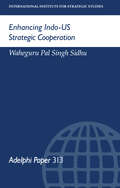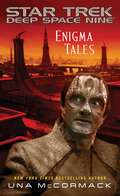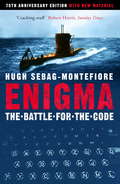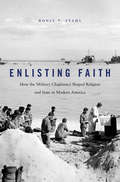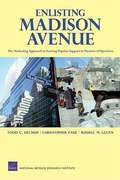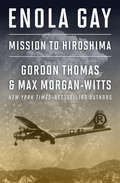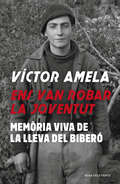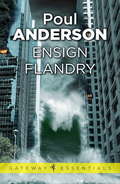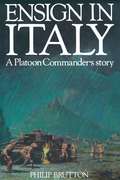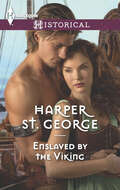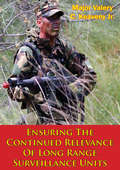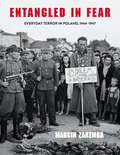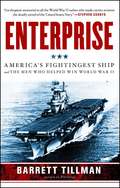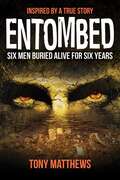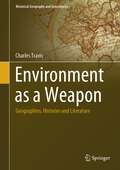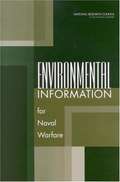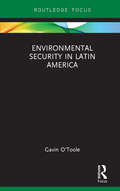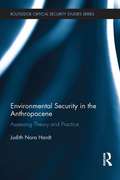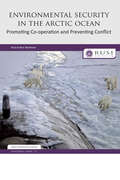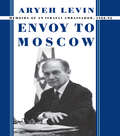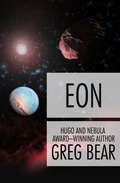- Table View
- List View
Enhancing Indo-US Strategic Cooperation (Adelphi series #No.313)
by Waheguru Pal Singh SidhuArgues that a carrot-and-stick policy is likely to be more effective than a stick-only approach in curbing India's nuclear ambitions. Increased strategic cooperation between India and the US is the ideal incentive, but the author argues that such cooperation is unlikely in the immediate future.
Enigma
by Robert HarrisA gripping World War II mystery novel with a cryptographic twist, Enigma's hero is Tom Jericho, a brilliant British mathematician working as a member of the team struggling to crack the Nazi Enigma code.
Enigma Tales (Star Trek)
by Una MccormackFrom the New York Times bestselling author of The Fall: The Crimson Shadow comes a compelling and suspenseful tale of politics and power set in the universe of Star Trek: Deep Space Nine.Elim Garak has ascended to Castellan of the Cardassian Union...but despite his soaring popularity, the imminent publication of a report exposing his people's war crimes during the occupation on Bajor looks likely to set the military against him. Into this tense situation come Dr. Katherine Pulaski—visiting Cardassia Prime to accept an award on behalf of the team that solved the Andorian genetic crisis—and Dr. Peter Alden, formerly of Starfleet Intelligence. The two soon find themselves at odds with Garak and embroiled in the politics of the prestigious University of the Union, where a new head is about to be appointed. Among the front-runners is one of Cardassia’s most respected public figures: Professor Natima Lang. But the discovery of a hidden archive from the last years before the Dominion War could destroy Lang’s reputation. As Pulaski and Alden become drawn into a deadly game to exonerate Lang, their confrontation escalates with Castellan Garak—a conflicted leader treading a fine line between the bright hopes for Cardassia’s future and the dark secrets still buried in its past... ™, ®, & © 2016 CBS Studios, Inc. Star Trek and related marks are trademarks of CBS Studios, Inc. All Rights Reserved.
Enigma: The Battle For The Code
by Hugh Sebag-MontefioreThe complete story of how the German Enigma codes were broken. Perfect for fans of THE IMITATION GAME, the new film on Alan Turing's Enigma code, starring Benedict Cumberbatch.Breaking the German Enigma codes was not only about brilliant mathematicians and professors at Bletchley Park. There is another aspect of the story which it is only now possible to tell. It takes in the exploits of spies, naval officers and ordinary British seamen who risked, and in some cases lost, their lives snatching the vital Enigma codebooks from under the noses of Nazi officials and from sinking German ships and submarines. This book tells the whole Enigma story: its original invention and use by German forces and how it was the Poles who first cracked - and passed on to the British - the key to the German airforce Enigma. The more complicated German Navy Enigma appeared to them to be unbreakable.
Enigma: The Battle For The Code
by Hugh Sebag-MontefioreThe complete story of how the German Enigma codes were broken. Perfect for fans of THE IMITATION GAME, the new film on Alan Turing's Enigma code, starring Benedict Cumberbatch.Breaking the German Enigma codes was not only about brilliant mathematicians and professors at Bletchley Park. There is another aspect of the story which it is only now possible to tell. It takes in the exploits of spies, naval officers and ordinary British seamen who risked, and in some cases lost, their lives snatching the vital Enigma codebooks from under the noses of Nazi officials and from sinking German ships and submarines. This book tells the whole Enigma story: its original invention and use by German forces and how it was the Poles who first cracked - and passed on to the British - the key to the German airforce Enigma. The more complicated German Navy Enigma appeared to them to be unbreakable.
Enlisting Faith: How the Military Chaplaincy Shaped Religion and State in Modern America
by Ronit Y. StahlRonit Stahl traces the ways the U.S. military struggled with, encouraged, and regulated religious pluralism and scrambled to handle the nation’s deep religious, racial, and political complexity. Just as the state relied on religion to sanction combat missions and sanctify war deaths, so too did religious groups seek validation as American faiths.
Enlisting Madison Avenue: The Marketing Approach to Earning Popular Support in Theaters of Operation
by Christopher Paul Todd C. Helmus Russell W. GlennVirtually every action, message, and decision of a military force shapes the opinions of an indigenous population: strategic communication, treatment of civilians at vehicle checkpoints, and the accuracy or inaccuracy of aerial bombardment. Themes of U.S. goodwill mean little if its actions convey otherwise. Consequently, a unified message in both word and deed is fundamental to success. Business marketing practices provide a useful framework for improving U.S. military efforts to shape the attitudes and behaviors of local populations in a theater of operations as well as those of a broader, international audience. Enlisting Madison Avenue extracts lessons from these business practices and adapts them to U.S. military efforts, developing a unique approach to shaping that has the potential to improve military-civilian relations, the accuracy of media coverage of operations, communication of U.S. and coalition objectives, and the reputation of U.S. forces in theater and internationally. Foremost among these lessons are the concepts of branding, customer satisfaction, and segmentation of the target audience, all of which serve to maximize the impact and improve the outcome of U.S. shaping efforts.
Enola Gay: Mission to Hiroshima
by Gordon Thomas Max Morgan-WittsFrom theNew York Times–bestselling coauthors: A &“fascinating . . . unrivaled&” history of the B-29 and its fateful mission to drop the atomic bomb on Hiroshima (The New York Times Book Review). Painstakingly researched, the story behind the decision to send the Enola Gay to bomb Hiroshima is told through firsthand sources. From diplomatic moves behind the scenes to Japanese actions and the US Army Air Force&’s call to action, no detail is left untold. Touching on the early days of the Manhattan Project and the first inkling of an atomic bomb, investigative journalist Gordon Thomas and his writing partner Max Morgan-Witts, take WWII enthusiasts through the training of the crew of the Enola Gay and the challenges faced by pilot Paul Tibbets. A page-turner that offers &“minute-by-minute coverage of the critical periods&” surrounding the mission, Enola Gay finally separates myth and reality from the planning of the flight to the moment over Hiroshima when the atomic age was born (Library Journal).
Ens van robar la joventut: Memòria viva de la Lleva del biberó
by Victor AmelaEns van robar la joventut narra les històries dels «biberons» que van combatre a l'Ebre, dels adolescents que es van allistar voluntaris (tant a l'exèrcit republicà com al de Franco), dels que van sobreviure i (alguns) van continuar la seva lluita a la Guerra Mundial, dels que van ser empresonats i dels que van morir en el camp de batalla. Cap al final de la Guerra Civil, 27.000 nois nascuts l'any 1920 van ser cridats a files. Se'ls va conèixer com la Lleva del Biberó i molts d'ells ni tan sols tenien divuit anys quan van perdre la vida a la sagnant batalla de l'Ebre. Els supervivents van acabar en penals i en presons franquistes, en camps de concentració o en batallons disciplinaris, i van haver de fer després un llarg servei militar. Tots van conservar de per vida el terrible record d'aquella guerra en la qual van combatre amb espardenyes i sense cartutxeres. La sarna, els polls, la set, les caminades, la metralla. Les veus trencades dels nois moribunds al camp de batalla cridant a les seves mares. Els companys morts, enterrats a centenars a la Venta de les Camposines. Un malson repetit nit rere nit, i durant anys, en el moment de tancar els ulls. La certesa que els havien robat la joventut. Víctor Amela ha recopilat el valuós testimoni de vint-i-cinc supervivents i ha reconstruït amb una investigació minuciosa la memòria d'aquests nois que van viure uniformats dels disset als vint anys. I aquestes commovedores històries humanes constitueixen -gràcies al rigor periodístic de l'autor i a la seva passió en la narració dels fets- en l'homenatge necessari i sentit als herois anònims de la Lleva del Biberó quan tot just ara es compleix el centenari del seu naixement.
Ensign Flandry: A Flandry Book (Gateway Essentials #7)
by Poul AndersonDominic Flandry had a great future ahead of him as saviour of the civilised universe. In later years his talent for swift, decisive action would give him an intergalactic reputation. But at the age of nineteen and straight out of naval academy, he was just another raw ensign.The mighty Merseian Empire had sworn to wipe the Earth from the face of the universe. The attack had already been launched, but no one knew how or where the ravening power of the savage green skinned aliens would strike. Only Ensign Flandry had the answer, in the form of a code which he might - or might not - be able to decipher.And so the Merseians were coming after Flandry with every weapon in their terrible arsenal. And just to make things worse, Earth's own armadas were after him too - for desertion, high treason and other assorted crimes. Even for a future saviour, times were looking pretty tough.
Ensign in Italy: A Platoon Commander's Story
by Philip BurtonIn 1943, aged 18, Philip Brutton relinquished his place at Cambridge to volunteer for the Welsh Guards. He was commissioned the same year and was Ensign of the Guard as St James's Palace when a near miss by the Luftwaffe hit and badly damaged the surrounding area. At 19, in early 1944, he was sent to Italy where he joined his Regiment and was soon on patrol in the dead-man's-land of the Cassino ruins, threading his way nightly through the minefields, under constant threat of enemy attack, shelling and mortaring. He survived to fight with the 3rd Battalion Welsh Guards as a young battle-hardened platoon commander throughout the major encounters of the Italian campaign involving 1st Guards' Brigade. In Austria, under orders, he handed over the Croatian Government and then 2000 men plus their families to their communist executioners: the Great Betrayal. A regular officer, he was stationed in Palestine before the end of the British Mandate, and after a period with The Prince of Wales's Company, 1st Battalion Welsh Guards, he became a Staff Captain at Headquarters 1st Guards' Brigade, aged 21.
Enslaved by the Viking: An Intense Story of Forbidden Passion (Viking Warriors #1)
by Harper St. George"From this day forward, you are mine." The moment Merewyn sets eyes on the warrior standing atop a Viking raiding ship, something inside her stirs. By all rights, she should fear him, should run from him, yet she cannot help but be drawn to him. Eirik has never before taken a woman captive, yet Merewyn inspires a longing that calls to the darkness within him. He takes her back to his homeland as his slave, where they finally succumb to passion. And as the lines between captor and captive blur, Eirik realizes they have crossed into dangerous territory...
Ensuring The Continued Relevance Of Long Range Surveillance Units
by Major Valery C. Keaveny Jr.Long Range Surveillance Units (LRSUs) provide a unique and necessary capability to today's commanders and to commanders who will fight in the future. In looking to the future operational environment, LRSUs must ensure their ability to operate across the full spectrum of operations at a rapid tempo and in a short-notice, force projection Army. Current LRSU doctrine is primarily built around the AirLand Battle doctrine of the Cold War, a conventional threat, linear battlefield, and employment at great distances behind enemy lines. As a result, LRSU doctrine and Tactics, Techniques, and Procedures (TTPs) require update or change. These changes will ensure continued LRSU relevance and their maximum effectiveness.This study identifies an increased and unaddressed emphasis on target acquisition, Stability and Support Operations, and operations in urban environments. These operations lend themselves to non-traditional and creative tasking of LRSUs and will necessitate increased requirements for friendly unit coordination, vehicular insertion, and potential task organization of reconnaissance elements.This study recommends changes to doctrine, tactics, techniques, procedures, and training based on lessons learned by LRSUs on recent operational missions and the lessons of similar units. These changes require proponent leadership, LRS community teamwork, and warrant additional Army oversight and assistance.
Entangled in Fear: Everyday Terror in Poland, 1944–1947
by Marcin Zaremba"Fear is always experienced individually, and few experiences are as personal. There can be no collective fear without individual fear preceding it. A society's fear is born out of the convergence of individual experiences, when dozens, hundreds, thousands, and millions of people are afraid of the same thing at the same time." This is a story about postwar Polish society and its emotions. This is a story of heroes: soldiers, deserters, orphans, and beggars. Now available in English for the first time, Entangled in Fear reveals the broken society where bandits, hunger, bombs, Russia, and countless other threats had an immense influence on Poles as they struggled through the wreckage caused by World War II. Journalist and historian Marcin Zaremba uses sociology, psychology, and history to explore collective fear in official documents and the personal papers of those who were left to survive in postwar Poland. In doing so, he reveals how fear of famine and epidemics, sexual violence and looting, joblessness and invasion led directly to collective action on the part of Poles. A groundbreaking work, Entangled in Fear challenges the reader to consider how emotions have shaped human history and how a more serious engagement with emotions is key to a fuller understanding of the past.
Enterprise: America's Fightingest Ship and the Men Who Helped Win World War II
by Barrett TillmanThis is the epic and heroic story of the aircraft carrier USS Enterprise and of the courageous men who fought and died on her from Pearl Harbor to the end of the conflict. Acclaimed military historian Barrett Tillman recounts the World War II exploits of America’s most decorated warship and its colorful crews— tales of unmatched daring and heroism.
Entombed: Six Men Buried Alive for Over Six Years
by Tony MatthewsWhat would it be like to be trapped deep underground for six long years with no hope of rescue or escape? This is a profound question explored deeply in Entombed. And the key point here is that Entombed is inspired by an astonishing true story and real events. Six German soldiers led by Captain Hans von Roth are accidentally buried alive in a vast subterranean stores bunker at the port of Gdynia, Poland, in 1945. At first they believe they will soon be rescued, but as the weeks drag into years it becomes appallingly clear that the men will almost certainly face a terrifying death in the grim darkness that surrounds them. Meanwhile, in Berlin, Hans von Roth&’s wife, Erika, is desperately attempting to survive the fall of the city and the Russian hordes destined shortly to occupy it. Facing starvation, massive aerial bombing, Soviet shelling and a host of other dangers, she is also attempting to discover what has become of her lost husband. In Entombed, the author has woven a tale of great love and a desperate struggle for survival like no other. The story literally pushes all the frontiers of human frailty and courage to their very edges.
Environment as a Weapon: Geographies, Histories and Literature (Historical Geography and Geosciences)
by Charles TravisEnvironment as a Weapon considers how the confluence of war and nature from the time of the Agricultural Revolution (10,000 BCE) to our present day has been represented in works of history, geography, and literature. In the Epic of Gilgamesh, the Torah and Greco-Roman myths, warfare is a trope commensurate with environmental disasters, extreme climate, and plague. In the medieval age myths the Táin, and Beowulf environments become allies and enemies. The equestrian steppeland as foundation of Genghis Khan’s and his heirs Pax Mongolica is chronicled in The Secret History of the Mongols and The Travels of Marco Polo. The West African Griot legend of Sundiata and the Little Ice Age wreck of the Spanish Armada in 1588 speak to oceanic and atmospheric dimensions of warfare. American Revolution political pamphlets, poetry, diaries and weather logs, reflect the severe weather and terrain deployed by George Washington’s early campaigns in the war of independence. Napoleon’s midwifing of Total War is captured in Mary Shelley’s Frankenstein, Leo Tolstoy’s War and Peace, and Charles Minard’s Carte figurative carto-graph of the disastrous 1812 French invasion of Russia. The U.S. Civil War and the organic-industrial assembles of its battles, arguably the first Anthropocene War, is parsed by the clarifying poetry of Emily Dickinson. Geopolitik and geo-hazards of flood and fire feature in the Global War works of Samuel Beckett, Kurt Vonnegut and James Dickey. The literature of Vietnamese and American war combat veterans reveals how North Vietnam’s Environmental Military Complex stalled the American Military Industrial Complex in the jungles, and R&R districts of southwestern Asia. Finally, he sci-fi of H.G. Wells’ World Set Free and David Mitchell’s Cloud-Atlas frame Oppenheimer’s sub-atomic deployments at Hiroshima and Nagasaki, James Lovelock’s ‘Gaia’ and U.S. military discourses situating global warming as a national security threat to America. Indeed, Environment and War ironically resonates with U.N. Secretary General António Guterres proclamation that “seventy-five years ago, the world emerged from a series of cataclysmic events: two successive world wars, genocide, a devastating influenza pandemic . . . Our founders gathered in San Francisco promising to save succeeding generations from the scourge of war.” Thus, a holistic approach to studying and mitigating the human and environmental impacts of warfare, must integrate methods from the arts, humanities and sciences. This involves understanding how the historical geographies of the Earth’s planetary systems have been perceived, deployed and emerged as agents of warfare, with the lithosphere, hydrosphere, cryosphere, biosphere and atmosphere transformed as arsenals against anthropogenic global warming. This book will be of interest to geographers, historians, and scholars in environmental studies, climate change, literature and military studies, as well as the broader environmental humanities.
Environmental Cleanup at Navy Facilities: Risk-Based Methods
by National Research CouncilThe fiscal and technological limitations associated with cleaning up hazardous waste sites to background conditions have prompted responsible parties to turn to risk-based methods for environmental rememdiation.Environmental Cleanup at Navy Facilities reviews and critiques risk-based methods, including those developed by the U.S. Environmental Protection Agency and the American Society of Testing and Materials. These critiques lead to the identification of eleven criteria that must be part of any risk-based methodology adopted by the Navy, a responsible party with a large number of complex and heavily contaminated waste sites. January
Environmental Information for Naval Warfare
by Committee on Environmental Information for Naval UseAccurate and timely environmental information can provide a tactical advantage to U. S. naval forces during warfare. This report analyzes the current environmental information system used by the U. S. Navy and Marine Corps and recommends ways to address uncertainty and leverage network-centric operating principles to enhance the value of environmental information.
Environmental Security in Latin America
by Gavin O'TooleThis book examines security in Latin America through an environmental lens, at a time when this region faces a broad and growing spectrum of threats. The book considers the backdrop against which security debates about Latin America have been conducted; the extent to which scholarship has been dominated by traditional US strategic concerns; and how, in the changing context at the end of the Cold War, some policymakers within Latin America itself at both national and regional levels began to reposition security. It argues that traditional security scholarship focusing on military defence and strategic affairs in this region is hard to explain and out of date, and offers reasons why a new focus on environmental threats within a broader human security perspective has much to offer this field. Such a focus is justified by the scale of the challenges that environmental degradation is posing in Latin America, and the very real impact of climate change there. The book considers how the various theoretical possibilities of the term ‘environmental security’ all have some potential application to this region, where the natural environment is rapidly being securitized by military forces on behalf of their states. Finally, it proposes that a fruitful approach to Latin America might be one where human and environmental security have parity. This book will be of interest to students of environmental security, Latin American security, human geography and IR in general.
Environmental Security in the Anthropocene: Assessing Theory and Practice (Critical Security Series)
by Judith Nora HardtThis book provides a critical assessment of the theories and practice of environmental security in the context of the Anthropocene. The work analyses the intellectual foundations, the evolution and different interpretations, strengths and potential of the link between environment and security, but also its weaknesses, incoherencies and distortions. To do so, it employs a critical environmental security studies analytical framework and uniquely places this analysis within the context of the Anthropocene. Furthermore, the book examines the practice–theory divide, and the political implementation of the environmental security concept in response to global environmental change and in relation to different actors. It pays significant attention to the Environment and Security Initiative (ENVSEC), which is led by different programs of the United Nations, the OSCE and until recently by the North Atlantic Treaty Organization (NATO), among others, and has largely been overlooked in the academic literature to date. The goal is to study how environmental security practice could inform and shape the environmental security theory, and also to explore how, conversely, new theoretical insights could contribute to the enhancement of environmental security activities. This book will be of great interest to students and academic scholars of Environmental Security, Critical Security Studies, Green Political Theory, Global Governance and International Relations in general.
Environmental Security in the Arctic Ocean: Promoting Co-operation and Preventing Conflict (Whitehall Papers)
by Paul Arthur BerkmanThe North Pole is being transformed from a sea-ice cap to a seasonally ice-free sea within the next few decades. This fundamental shift in the boundary conditions of the Arctic Ocean will create a new natural system with different dynamics than anything previously experienced by humans in the region. With the diminishing ice cover, interests are awakening globally to take advantage of extensive energy, shipping, fishing and tourism prospects in the Arctic Ocean. A range of states, including the major Arctic powers, are increasingly asserting their sovereignty seawards. National security policies are being declared and nuclear-capable states are adjusting their strategic deployments in the Arctic Ocean. There are forums for international cooperation in the Arctic, most notably the Arctic Council, but peace in the Arctic Ocean has yet to be explicitly established as a common interest because of the long-standing military presence. Risks of political, economic and cultural instabilities are inherent consequences. This volume proposes environmental security as providing a holistic framework to assess these security risks and then identify the appropriate adaptation and mitigation responses. Only after shared risk assessment and understanding of the appropriate responses, will there be sufficient clarity about the governance paths to pursue within the international legal framework of the law of the sea.
Envoy to Moscow: Memories of an Israeli Ambassador, 1988-92 (Cummings Center Series #Vol. 4)
by Aryeh LevinThe personal memoir of Aryeh Levin, Israel's first Ambassador to Russia since the severance of relations between the two countries in 1967. Aryeh Levin's four-year tenure as Ambassador to Moscow coincided with great upheavals in the life and times of both Israel and Russia. He was witness to the momentous events that led to the collapse of the Soviet empire and was instrumental in facilitating the immigration of almost half a million Jews to Israel.
Eon: A Novel (Eon #2)
by Greg BearFrom the New York Times–bestselling author of War Dogs: A novel that &“may be the best constructed hard SF epic yet&” (The Washington Post). In a supernova flash, the asteroid arrived and entered Earth&’s orbit. Three hundred kilometers in length, it is not solid rock but a series of hollowed-out chambers housing ancient, abandoned cities of human origin, a civilization named Thistledown. The people who lived there survived a nuclear holocaust that nearly rendered humanity extinct—more than a thousand years from now. To prevent this future from coming to pass, theoretical mathematician Patricia Vasquez must explore Thistledown and decipher its secret history. But what she discovers is an even greater mystery, a tunnel that exists beyond the physical dimensions of the asteroid. Called the Way, it leads to the home of humanity&’s descendants, and to a conflict greater than the impending war between Earth&’s superpowers over the fate of the asteroid, in &“the grandest work yet&” by Nebula Award–winning author Greg Bear (Locus).
Eon: A Novel (Eon #2)
by Greg BearFrom the New York Times–bestselling author of War Dogs: A novel that &“may be the best constructed hard SF epic yet&” (The Washington Post). In a supernova flash, the asteroid arrived and entered Earth&’s orbit. Three hundred kilometers in length, it is not solid rock but a series of hollowed-out chambers housing ancient, abandoned cities of human origin, a civilization named Thistledown. The people who lived there survived a nuclear holocaust that nearly rendered humanity extinct—more than a thousand years from now. To prevent this future from coming to pass, theoretical mathematician Patricia Vasquez must explore Thistledown and decipher its secret history. But what she discovers is an even greater mystery, a tunnel that exists beyond the physical dimensions of the asteroid. Called the Way, it leads to the home of humanity&’s descendants, and to a conflict greater than the impending war between Earth&’s superpowers over the fate of the asteroid, in &“the grandest work yet&” by Nebula Award–winning author Greg Bear (Locus).
